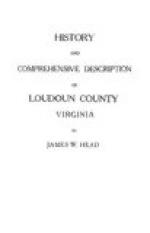At Leesburg the limestone conglomerate next the diabase is indurated, its iron oxide is driven off, and the limestone partly crystallized into marble.
Catoctin Schist.
The Catoctin schist is geographically the most important of the volcanic rocks of Loudoun.
Throughout its entire area the schist is singularly uniform in appearance, so that only two divisions can be made with any certainty at all. These are dependent upon a secondary characteristic, viz, the presence of epidote in large or small quantities. The epidote occurs in the form of lenses arranged parallel to the planes of schistosity, reaching as high as five feet in thickness and grading from that down to the size of minute grains. Accompanying this lenticular epidote is a large development of quartz in lenses, which, however, do not attain quite such a size as those of epidote. Both the quartz and epidote are practically insoluble and lie scattered over the surface in blocks of all sizes. In places they form an almost complete carpet and protect the surface from removal. The resulting soil, where not too heavily encumbered with the epidote blocks, is rich and well adapted to farming, on account of the potash and calcium contained in the epidote and feldspar.
Except along the narrow canyons in the Tertiary baselevel the rock is rarely seen unless badly weathered. The light bluish green color of the fresh rock changes on exposure to a dull gray or yellow, and the massive ledges and slabs split up into thin schistose layers. It is quite compact in appearance, and as a rule very few macroscopic crystals can be seen in it.
A general separation can be made into an epidotic division characterized by an abundance of macroscopic epidote and a non-epidotic division with microscopic epidote. These divisions are accented by the general finer texture of the epidotic schist.
The schists can be definitely called volcanic in many cases, from macroscopic characters, such as the component minerals and basaltic arrangement. In most cases, the services of the microscope are necessary to determine their nature. Many varieties have lost all of their original character in the secondary schistosity. None the less, its origin as diabase can definitely be asserted of the whole mass. In view of the fact, however, that most of the formation has a well defined schistosity destroying its diabasic characters, and now is not a diabase but a schist, it seems advisable to speak of it as a schist.
Sections of the finer schist in polarized light show many small areas of quartz and plagioclase and numerous crystals of epidote, magnetite, and chlorite, the whole having a marked parallel arrangement. Only in the coarser varieties is the real nature of the rock apparent. In these the ophitic arrangement of the coarse feldspars is well defined, and in spite of their subsequent alteration the fragments retain the crystal outlines and polarize together. Additional minerals found in the coarse schists are calcite, ilmenite, skeleton oblivine, biotite, and hematite.




